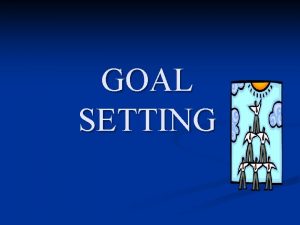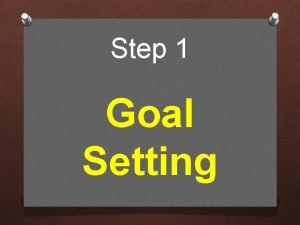GOAL SETTING Setting Goals for Teens Do You

















- Slides: 17

GOAL SETTING

Setting Goals for Teens Do You Want to… • Develop self-esteem? • Gain a positive outlook on the future? • Decrease unhealthy habits? • Improve your academic performance and organization? • Develop time-management skills and battle procrastination? Then YOU could benefit from goal setting!

What is Goal Setting? Goal setting is the process of working toward something you want to accomplish. Goals can: 1. Benefit and improve your overall health. 2. Think about what you want to accomplish in life. 3. Boost your self-confidence and strengthen your mental/emotional health.

What Types of Goals Are There? There are two basic types of goals: • Short-Term goals , goals that you can achieve in a short length of time. For instance, “I want to take better notes” is a short-term goal. • Long-Term goals , goals that you plan to reach over an extended period of time. For example, “I want to make the honor roll” is a long-term goal.

PRACTICE!!! AS A CLASS……. LET’S BRAINSTORM SOME SHORT TERM GOALS, AND THEN SOME LONG TERM GOALS.

Self Confidence Reaching goals can be a powerful boost to your self confidence. Examples: Getting your homework turned in on time might be a short-term goal. Long-term goals are generally accomplished over months or years. Getting a college education might be a long term goal

Long Term Goals Long-term goals are made up of several shortterm goals. Example: Jamie’s long-term goal is to be a veterinarian, an animal doctor. Her short-term goals include doing well in science and earning money for college. To achieve her short term goal, Jamie walks neighbors’ dogs. This also gives her experience running a business and being around animals.

The Long-Term Goal Chain 1. Jamie studies hard to achieve the goal of passing her science test. 2. She earns good grades to achieve the goal of getting into college. 3. Jamie started her own pet-sitting business. This helps her achieve the goal of paying for college.

Choosing Goals The goals that are right for you depend on your interests, skills, and abilities. Think about: What do you do well? What would you like to improve? Answering questions such as these will help you choose goals you will want to work toward!

Do’s and Dont’s of Goal Setting • Do a reality check. Ask yourself whether your goal is realistic. Is it something you can really achieve? • Don’t sell yourself short. Select goals that are challenging for you. Don’t be afraid to aim high. Believe in yourself, and use all your abilities.

Reaching Your Goals All goals BIG and SMALL have one thing in common. To achieve them, you have to plan. How do you get from where you are now to where you want to be?

Tips for Goal Setting STEP #1: Make your goal SPECIFC. Example: Don’t just say, “I want to be a better piano player. ” Say, “I want to be able to play a certain piece without making any mistakes at my next recital. ”

Tips for Goal Setting STEP #2 - List the steps to reach your goal Break big goals down into smaller tasks. For example, to play piano in the recital, you will need to practice. Set a practice schedule, maybe half an hour each day.

Tips For Goal Setting STEP #3: Get help from others Identify people who can help you achieve your goals. Seek the input of parents, teachers and other trusted adults. Also, identify sources of information, such as books and magazine articles.

Tips for Goal Setting Step #4: Evaluate Your Progress Check periodically to see how well you’re progressing through your goal. Example: In the case of the piano piece, you might record and play back your performances. Should you be doing anything differently? Is one part giving you more trouble than others?

Tips for Goal Setting Step #5: Reward Yourself Treat yourself in a special way, and celebrate your accomplishments!

Practice/Setting Goals Group Activity 1. Practice the five-step plan as a class (page 3) Kayla improving her basketball skills in time for tryouts. 2. Group activity-Groups of 3 or 4 3. You will need to help Yoko by using the five-step plan to help Yoko improve her energy level. 4. In your group develop a detailed, written plan for meeting the goal. 5. Remember to use the five-step plan that is outlined at the top of your Building Health Skills (page 3). 6. Be prepared to present your plan to the class tomorrow!
 Goal setting for teens
Goal setting for teens Strategic goals tactical goals operational goals
Strategic goals tactical goals operational goals Strategic goals tactical goals operational goals
Strategic goals tactical goals operational goals Long term goals for teens
Long term goals for teens T-tess teacher self assessment examples
T-tess teacher self assessment examples General goals and specific goals
General goals and specific goals Examples of generic goals and product-specific goals
Examples of generic goals and product-specific goals A-teens 사라 룸홀트
A-teens 사라 룸홀트 Nnteens
Nnteens Png
Png Nn teenz
Nn teenz How does digital media try to hook you
How does digital media try to hook you 7 defective habits
7 defective habits Tots tweens and teens
Tots tweens and teens 7 habits of highly effective teens lessons
7 habits of highly effective teens lessons Love language test teenager
Love language test teenager During early teens, what is reasoning like?
During early teens, what is reasoning like? 7 habits of highly effective teens quotes
7 habits of highly effective teens quotes

































